.
FRANCE 2012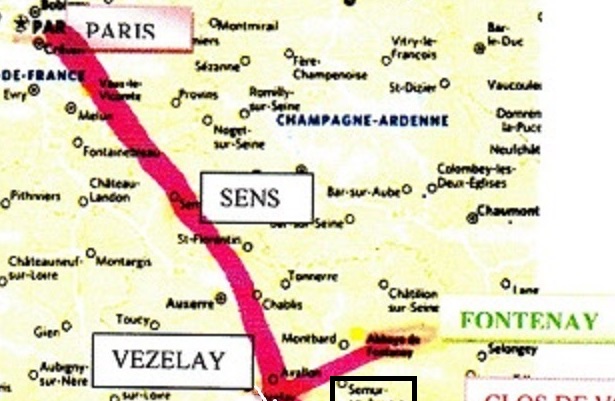
DAY 4, THURSDAY, SEPT.6
VEZELAY TO
ABBEY OF FONTENAY
We ate breakfast in the hotel's lovely breakfast room – cereals,
meats and cheese and a do it yourself hardboiled egg. We have
encountered the egg experience before. My wife's was sort of egg soup.
We left our hotel, and headed for Abbaye Fortenay which was about 50
miles away. After about 15 miles we were back on the main road that we
were on yesterday. We had to exit at another unmanned toll both, but we
did an excellent job…using only coins.
We had particularly wanted to see Abbaye Fontenay because it was one
of my MODELS. I was
almost finished with it when we left home. It is located in a very
isolated but green will being valley, and is a great example of a 12th
century Cistercian monastery.
The Abbey of Fontenay was founded by St. Bernard of Clairvaux,
founder of the Cistercian order, in 1118 on land he received from his
uncle.
Cistercian monks moved into the abbey in 1130. In 1139, the Bishop
of Norwich fled to Fontenay to escape persecution, and used his
considerable wealth to help finance the building of the abbey church.
The abbey church at Fontenay was consecrated by Pope Eugene III in
1147. By 1200 the monastic complex was almost complete and large enough
to house 300 monks.
In 1259, King Louis exempted the Abbey of Fontenay from all taxes,
and 10 years later the abbey became a French royal abbey. In 1359, the
Abbey of Fontenay was pillaged by the armies of King Edward III of
England during the Hundred Years' War. It further suffered during the
Wars of Religion. In 1745, the refectory was destroyed.
The French Revolution began in 1789 and the next year the last eight
monks left the abbey. The abbey was sold and turned into a paper mill in
1791.
For various reason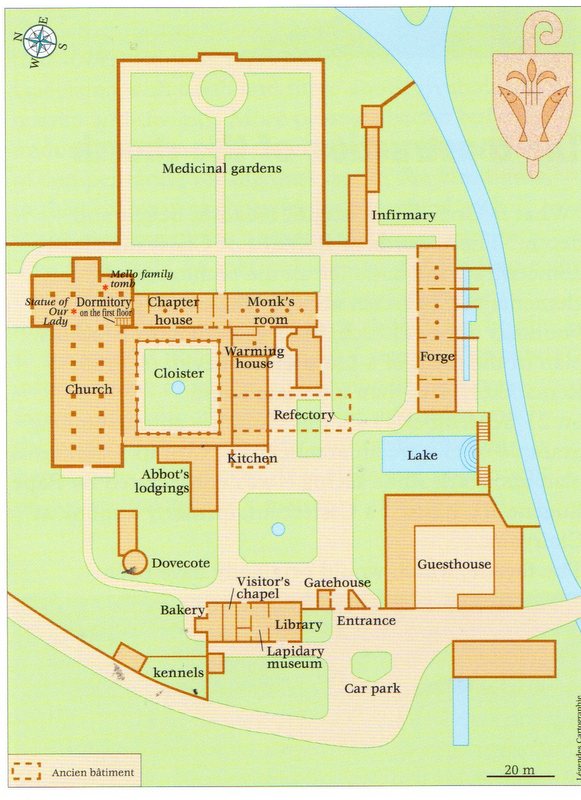 s, the Fontenay paper company went under in 1903. In
1906, an art-loving banker from Lyon named Edouard Aynard bought the
abbey with the intention of returning it to its medieval glory. From
1906 to 1911, all of the structures related to the paper mill, such as workshops and chimneys, were torn down. Meanwhile, the abbey church was
restored and excavated, revealing medieval tiles and tombs. Aynard's
descendents continued to work on the abbey and it remains in the family
today.
s, the Fontenay paper company went under in 1903. In
1906, an art-loving banker from Lyon named Edouard Aynard bought the
abbey with the intention of returning it to its medieval glory. From
1906 to 1911, all of the structures related to the paper mill, such as workshops and chimneys, were torn down. Meanwhile, the abbey church was
restored and excavated, revealing medieval tiles and tombs. Aynard's
descendents continued to work on the abbey and it remains in the family
today.
UNESCO declared the Abbey of Fontenay a World Heritage Site in 1981, and
restoration continued into the 1990s. In 1997, the abbey celebrated its
850th anniversary. Today the abbey welcomes nearly 120,000 visitors a
year.
In the Abbey complex consists of about a dozen beautiful buildings plus
wonderful gardens. It is no longer used as a monastery, but was a place
to visit as well as a place for conferences and meetings. A
governmental workshop was being held the day we visited but it did not
interfere with visitors wishing to tour all of the buildings.
Here is a diagram of the grounds and buildings. Photographs cannot
capture the entire complex, so have another look at
MY MODEL.
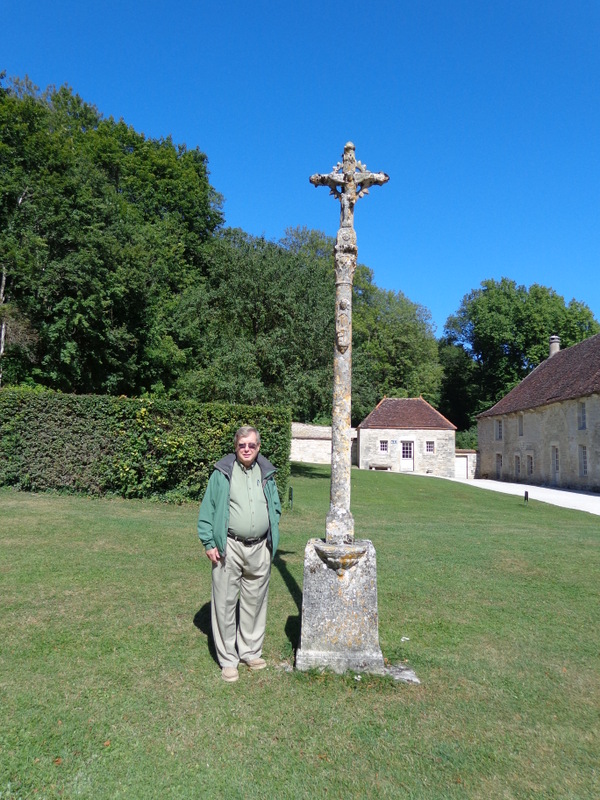
In the parking lot was an exceptionally high cross.
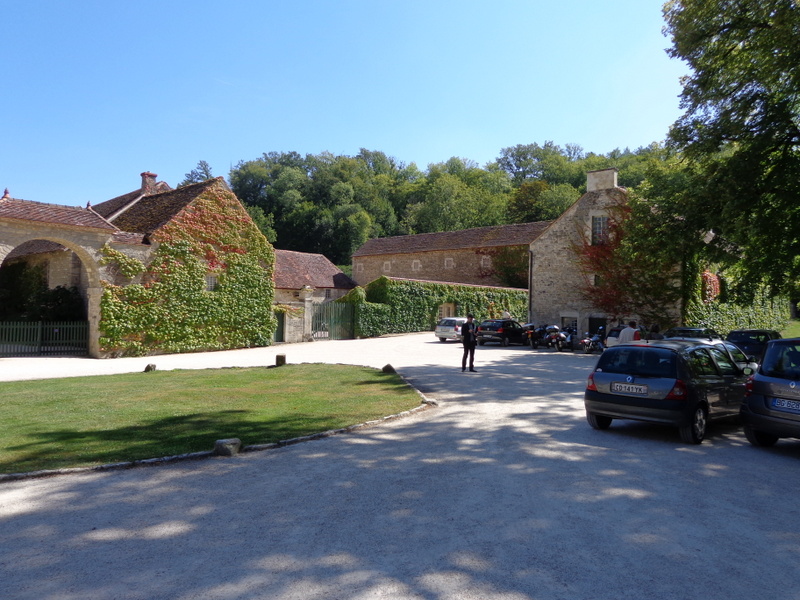
There was an entrance gate and office where the tickets were sold for
€10 a person.
As we entered we faced several buildings including the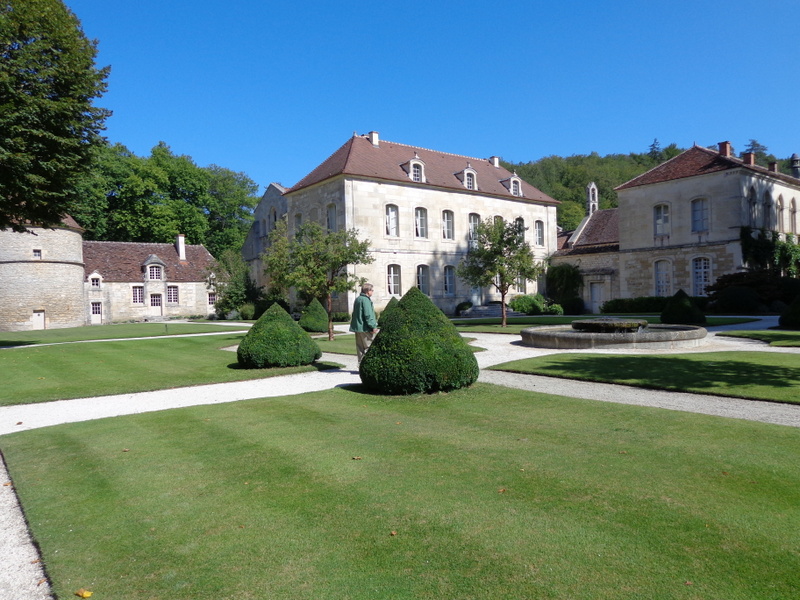 Abbotts Lodge,
the guesthouse and the dovecote which is on the left - a stone building
with a large round tower attached. The Dovecote was used for the keeping
of pigeons and dates from the 12th and 13th centuries.
Abbotts Lodge,
the guesthouse and the dovecote which is on the left - a stone building
with a large round tower attached. The Dovecote was used for the keeping
of pigeons and dates from the 12th and 13th centuries.
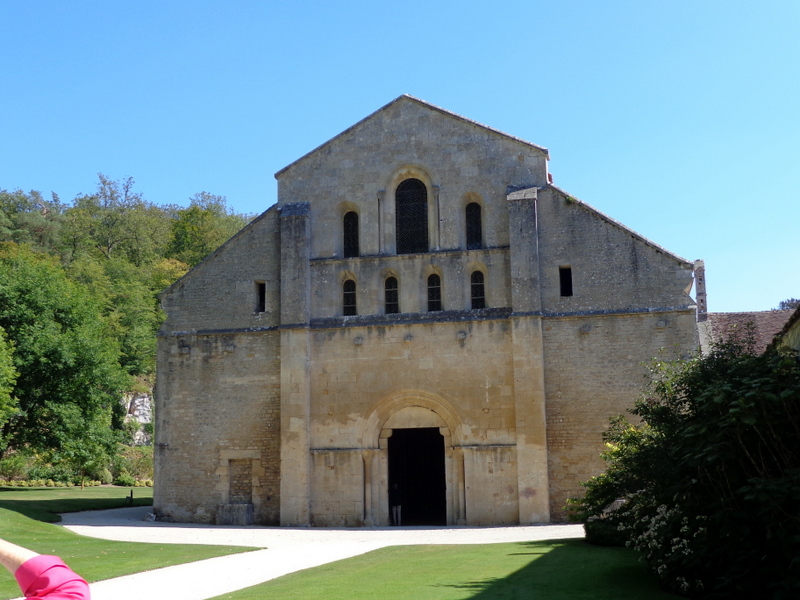
To the right of the dovecote and behind it is the church which
was built according to a Basilica plan in the form of Latin cross. It
was begun in 1139 and by 1147 was consecrated by Pope Eugene III,
himself a Cistercian, formerly a monk at Clairvaux. The façade is rather
plain, simply adorned by two buttresses to emphasize the internal
division between the nave and the side aisles. The central entrance is
topped by a semicircular archivolt, with two rows of semicircular
windows in the upper part.
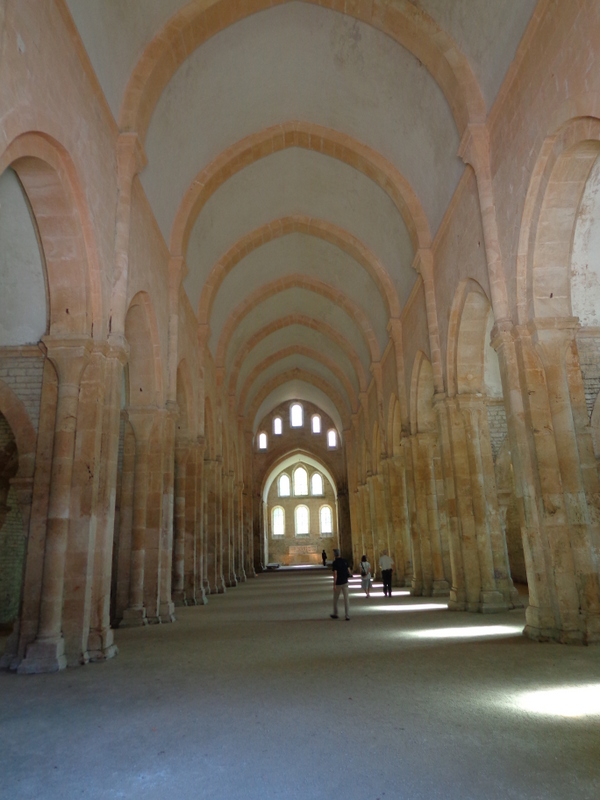
The church has a dirt floor, which is striking ,as we entered the large
nave which measures 216 feet in length and 55 feet wide with 8 bays. The
East end is a flat ended choir with a number of windows. The material
for the walls, pillars, arcades, and buttresses is white ashlar. The
capitals on top of the pillars are very simple, given that ornate
sculptures were forbidden under the rule of St. Benedict so as to
prevent any distraction.
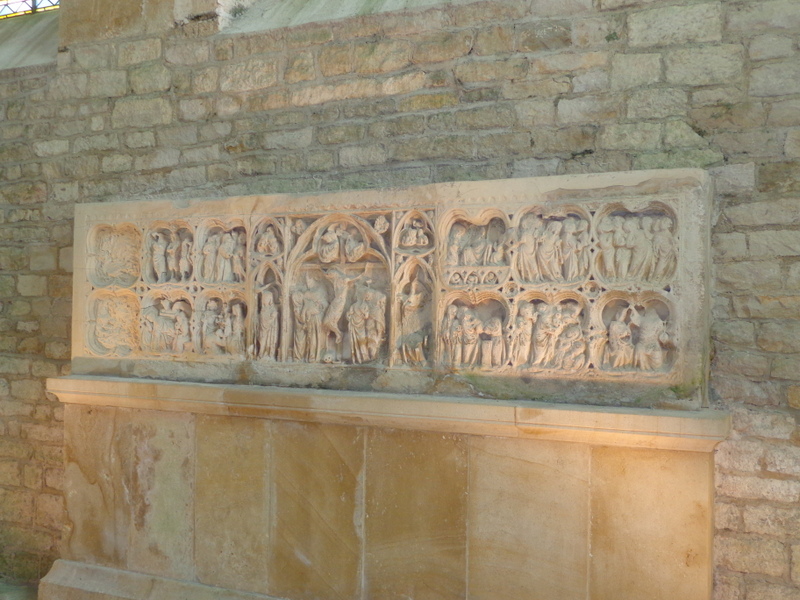
There is no free standing altar table in the choir but a shelf with an
amazing reredos carving depicting
the life of Christ
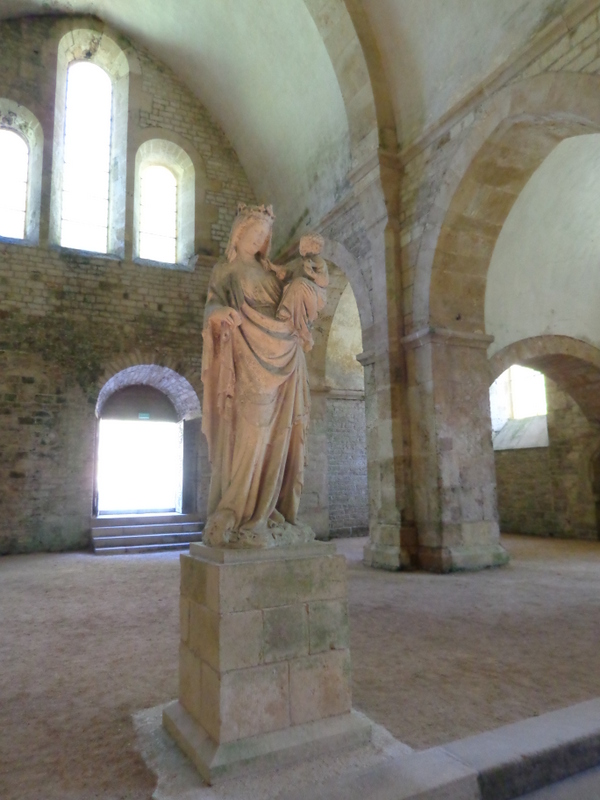
In the northern transept arm stands a remarkable example of late 13th
century Burgundian statuary. Mary crowned, carries the Christ child on
her left arm. In her right hand, she originally held a sceptre, which is
since disappeared. Her smile is typical of statuary from the Champagne
area. The statue was sold during the French Revolution and stood in a
cemetery for more than a century before being returned to the Abbey in
1929 at the initiative of the Aynard family.
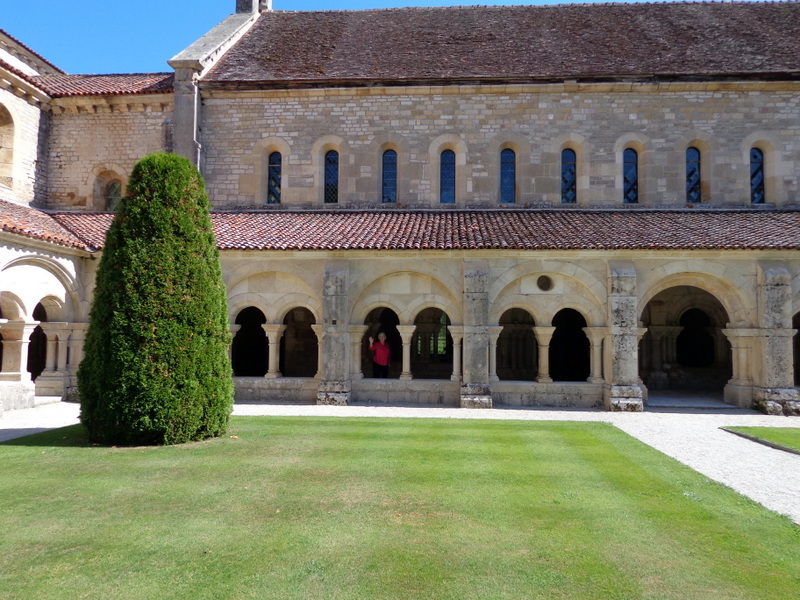
On the right side of the church is a lovely cloister.
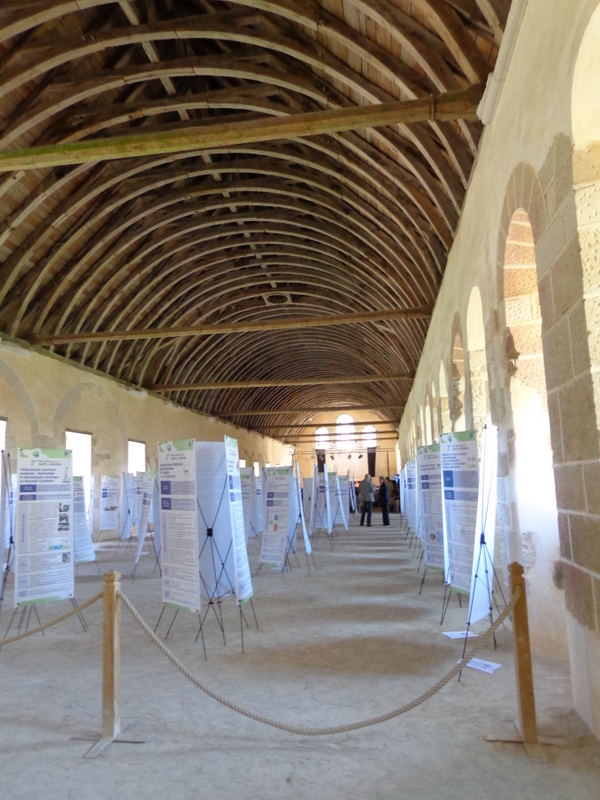 From the southern
transept arm of the church, a staircase leads to the dormitory, the same
staircase that the monks themselves use to go to the night office. Being
attached to the church allowed the monks to avoid any bad weather. All
he had to do was roll out of bed and be in church. The dormitory is 183
feet long. The ceiling is covered by an oak frame resembling the
upturned ships hull, dates from the second half of the 15th century.
This building was severely damaged by a fire during the Hundred Years
War. The conference, that was taking place that day, was using this
space and had a number of displays around the room.
From the southern
transept arm of the church, a staircase leads to the dormitory, the same
staircase that the monks themselves use to go to the night office. Being
attached to the church allowed the monks to avoid any bad weather. All
he had to do was roll out of bed and be in church. The dormitory is 183
feet long. The ceiling is covered by an oak frame resembling the
upturned ships hull, dates from the second half of the 15th century.
This building was severely damaged by a fire during the Hundred Years
War. The conference, that was taking place that day, was using this
space and had a number of displays around the room.
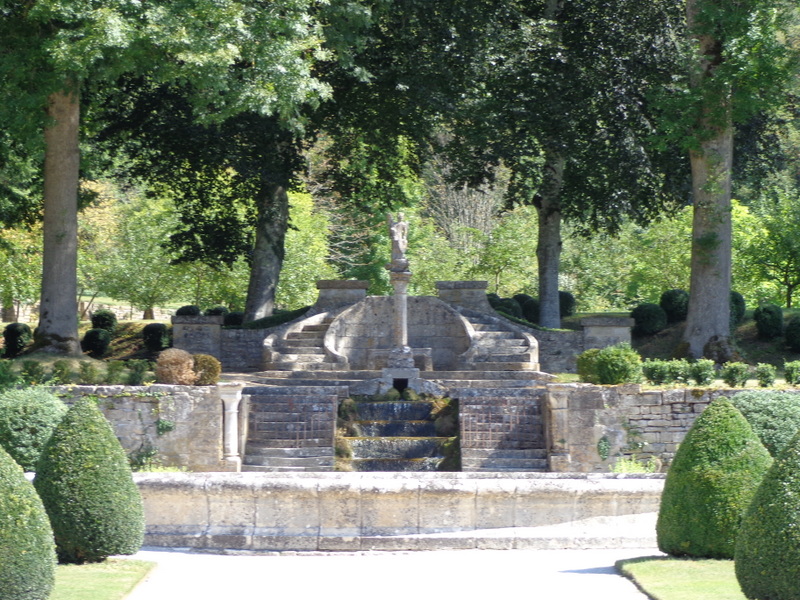
We walked around the outside
of the church and the dormitory behind
which was a lovely garden with a small fountain. It was set up for
luncheon for the conference that was taking place.
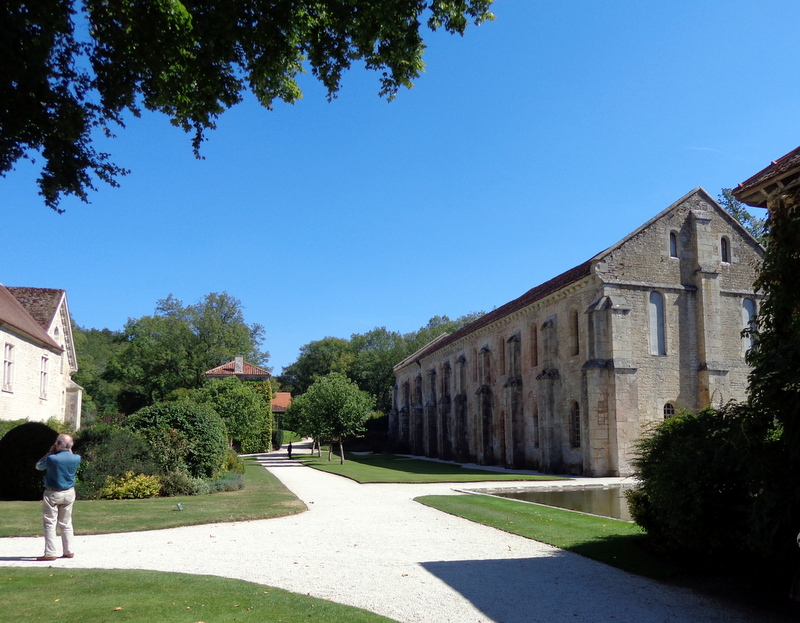
Our next stop was at
the forge. Covering about 740 sq ft, it is the largest known forge in
F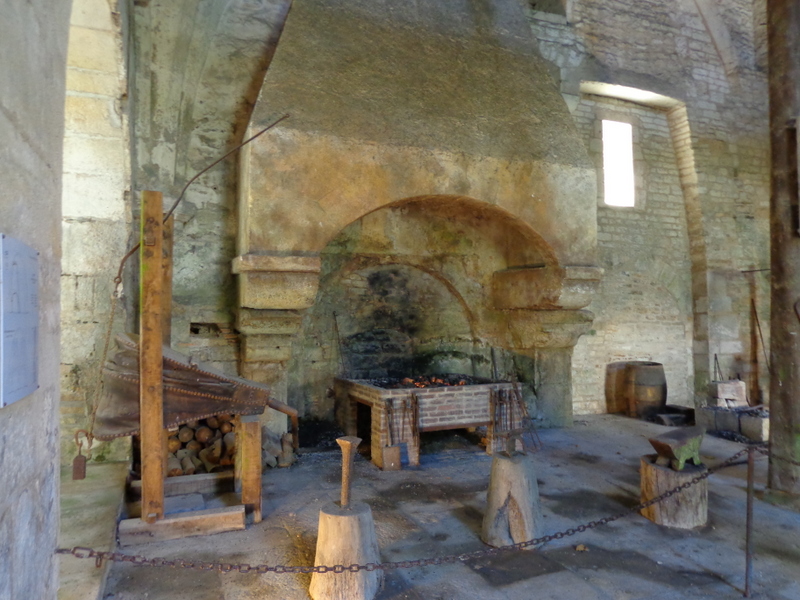 rance and England. After the paper mill had been destroyed during the
restoration, the forge was restored. It was operated by a waterwheel on
the outside.
rance and England. After the paper mill had been destroyed during the
restoration, the forge was restored. It was operated by a waterwheel on
the outside.
We spent several hours exploring and taking photos. It was so much fun
seeing the buildings that I had just built on the model. It was a
wonderful experience in a very beautiful setting. There wasn’t any place
to eat, and we hadn’t had lunch when we left
about 2:30.
SEMUR-EN-AUXOIS
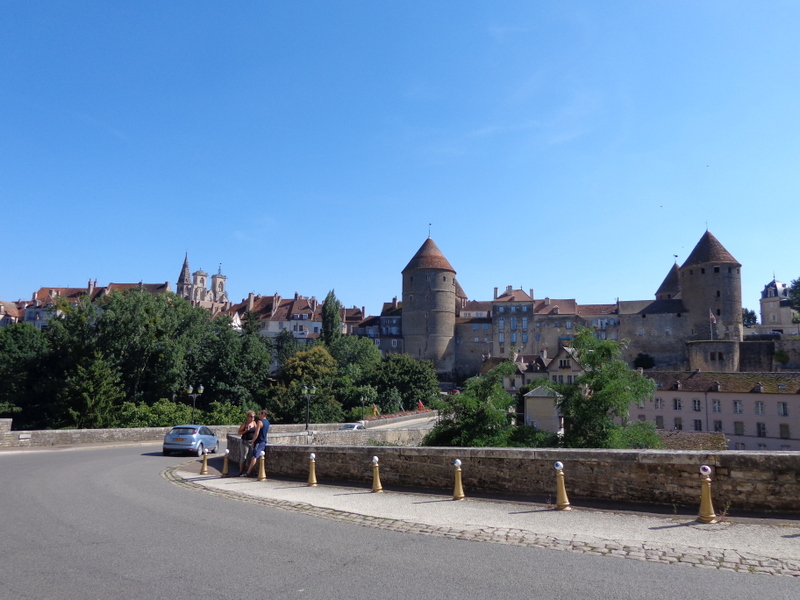 On our way to Fontenay, we had gone through the edge of a quaint town,
so we decided to explore it and look for lunch. It also had a wonderful
cathedral. The town was named Semur-en Auxois. It is the main center of
the Auxois agriculture and stock raising region. Semur became the
stronghold of the duchy in the 14th century when the Citadel was
reinforced by ramparts and 18 towers. The town was divided into three
parts, each with a perimeter wall.
On our way to Fontenay, we had gone through the edge of a quaint town,
so we decided to explore it and look for lunch. It also had a wonderful
cathedral. The town was named Semur-en Auxois. It is the main center of
the Auxois agriculture and stock raising region. Semur became the
stronghold of the duchy in the 14th century when the Citadel was
reinforced by ramparts and 18 towers. The town was divided into three
parts, each with a perimeter wall.
We kept climbing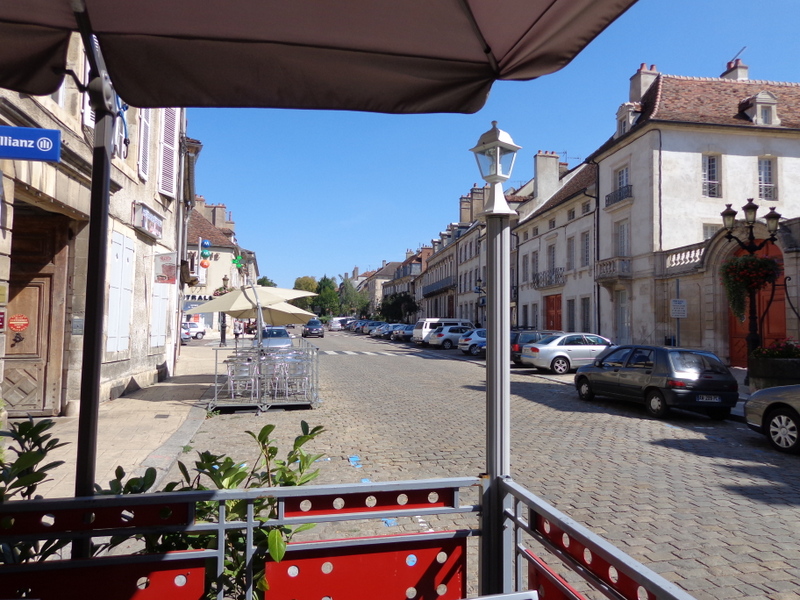 to the top which was the center of town and parked.
Across the street was an outdoor café so we stopped there for a ham and
cheese sandwich…very good. We saw a policeman look at our car, so I
rushed across the street…he was going to give me a parking ticket. The
owner of the restaurant saw what was happening and yelled at the
policeman and told him that he would take care of it. He filled
something out and went across and put a permit on my windshield. He was
very nice about it.
to the top which was the center of town and parked.
Across the street was an outdoor café so we stopped there for a ham and
cheese sandwich…very good. We saw a policeman look at our car, so I
rushed across the street…he was going to give me a parking ticket. The
owner of the restaurant saw what was happening and yelled at the
policeman and told him that he would take care of it. He filled
something out and went across and put a permit on my windshield. He was
very nice about it.
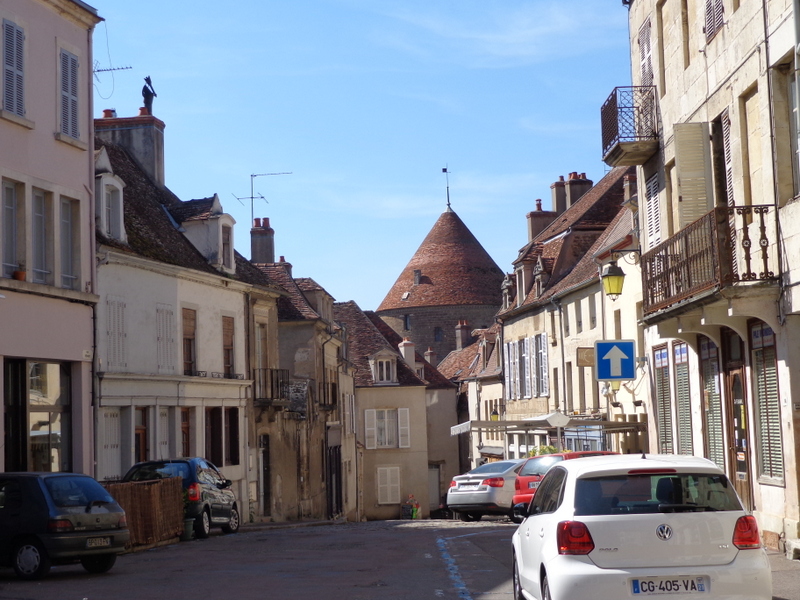 He told us that the cathedral and the old town was
just a half a block away, so we walked through a very interesting
section of shops and café and soon found the Notre-Dame
cathedral.
He told us that the cathedral and the old town was
just a half a block away, so we walked through a very interesting
section of shops and café and soon found the Notre-Dame
cathedral.
The Cathedral was very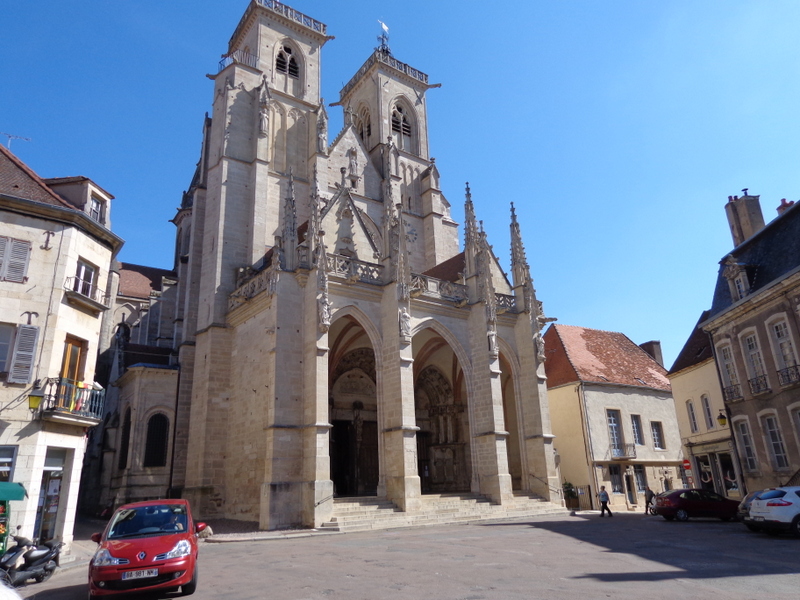 beautiful. The original had been built in the
11th century, Rebuilt in the 13th and 14th centuries, altered in the
15th and 16th century, extended by the addition of chapels to the north
side and restored by Viollet-le-Duc.
beautiful. The original had been built in the
11th century, Rebuilt in the 13th and 14th centuries, altered in the
15th and 16th century, extended by the addition of chapels to the north
side and restored by Viollet-le-Duc.
The façade had two square towers while the transept is topped with an
octagonal belfry. There was a large porch with three portals of the 15th
century.
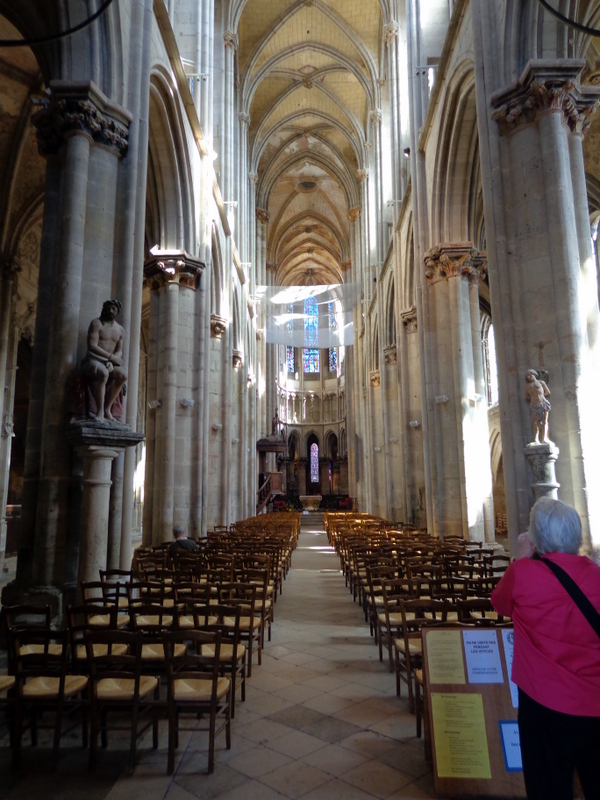
The nave, dating from the 13th and 14th centuries is narrow.
There are eight bays and the apse ends with three chapels. There were
beautiful stained glass windows through out the entire cathedral.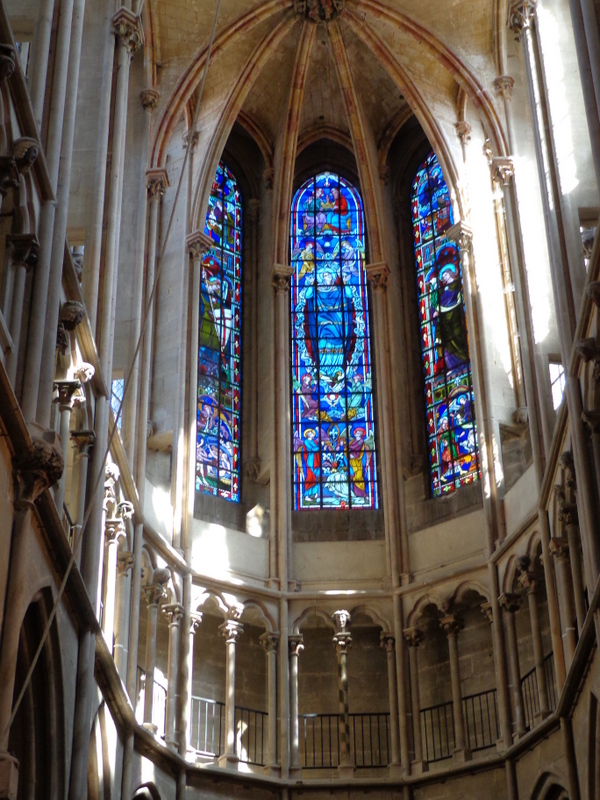
We arrived back at our hotel about 5:30, having made it successful
through another toll gate. We have been saving all of our coins so that
we would never run out at the toll gates.
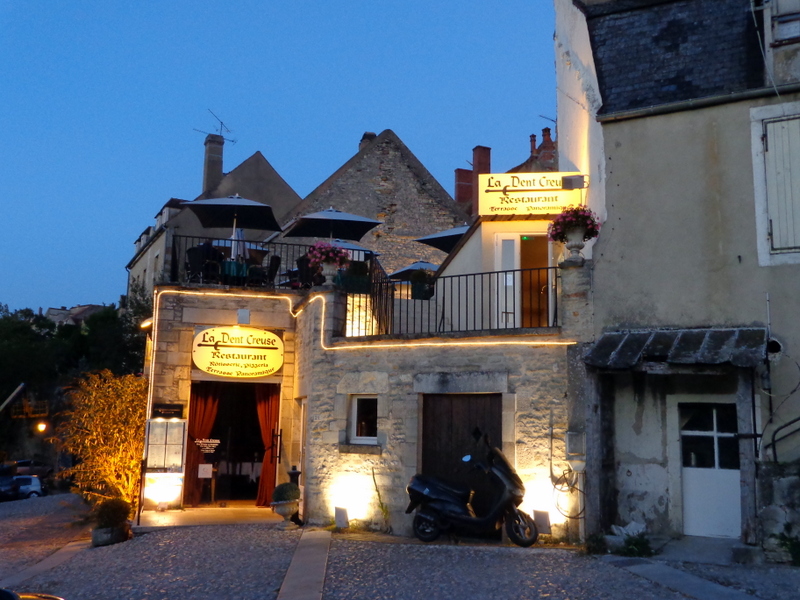 As usual my wife took a long nap. Then we went across the street
to a high terrace restaurant –La Dent Creuse Terrasse.
As usual my wife took a long nap. Then we went across the street
to a high terrace restaurant –La Dent Creuse Terrasse.
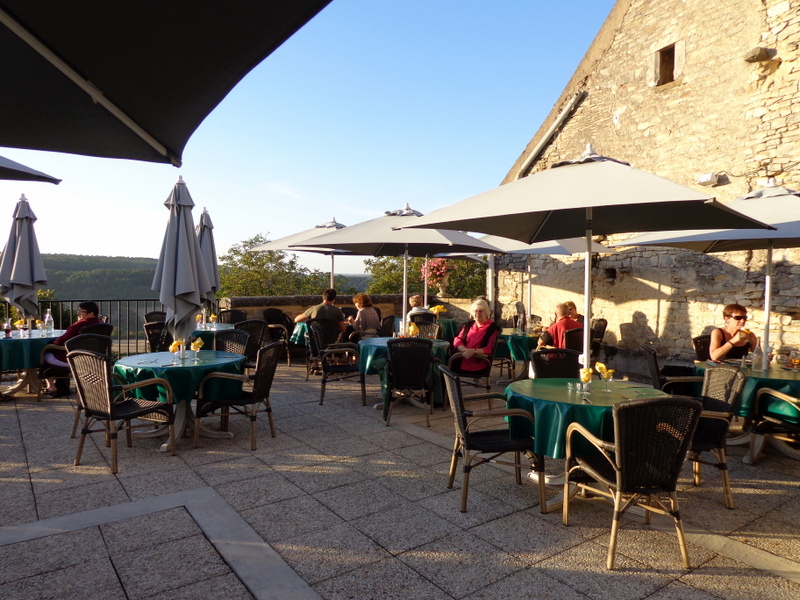 We had a
wonderful meal – I had curried lamb and she had chicken with mustard
sauce. It got rather chilly out- we were glad we brought our jackets.
Most of the people eating tonight were senior folks from other European
countries. A lot of people travel with their dogs.we have made several
new friends.
We had a
wonderful meal – I had curried lamb and she had chicken with mustard
sauce. It got rather chilly out- we were glad we brought our jackets.
Most of the people eating tonight were senior folks from other European
countries. A lot of people travel with their dogs.we have made several
new friends.
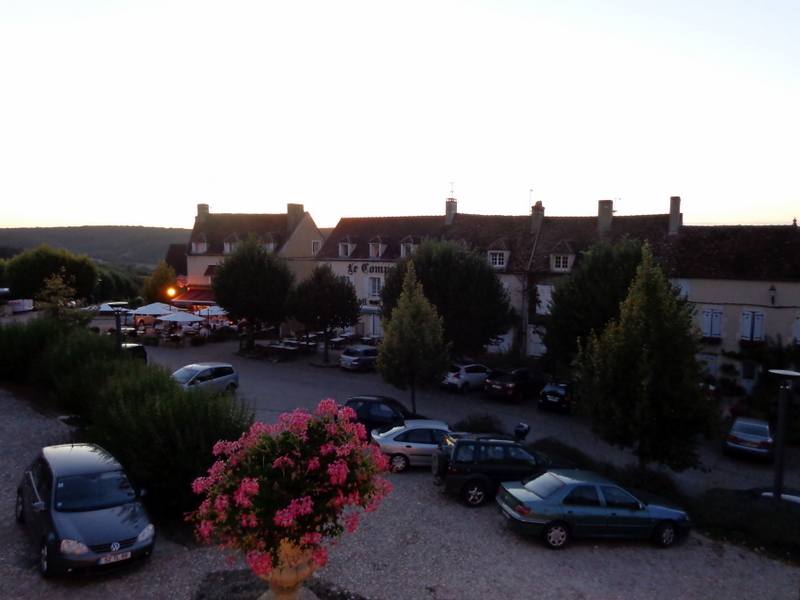
This wonderful little town of Vezelay is very deserted at night so we
went back to our hotel. It was a very enjoyable day.

 s, the Fontenay paper company went under in 1903. In
1906, an art-loving banker from Lyon named Edouard Aynard bought the
abbey with the intention of returning it to its medieval glory. From
1906 to 1911, all of the structures related to the paper mill, such as workshops and chimneys, were torn down. Meanwhile, the abbey church was
restored and excavated, revealing medieval tiles and tombs. Aynard's
descendents continued to work on the abbey and it remains in the family
today.
s, the Fontenay paper company went under in 1903. In
1906, an art-loving banker from Lyon named Edouard Aynard bought the
abbey with the intention of returning it to its medieval glory. From
1906 to 1911, all of the structures related to the paper mill, such as workshops and chimneys, were torn down. Meanwhile, the abbey church was
restored and excavated, revealing medieval tiles and tombs. Aynard's
descendents continued to work on the abbey and it remains in the family
today.
 Abbotts Lodge,
the guesthouse and the dovecote which is on the left - a stone building
with a large round tower attached. The Dovecote was used for the keeping
of pigeons and dates from the 12th and 13th centuries.
Abbotts Lodge,
the guesthouse and the dovecote which is on the left - a stone building
with a large round tower attached. The Dovecote was used for the keeping
of pigeons and dates from the 12th and 13th centuries. From the southern
transept arm of the church, a staircase leads to the dormitory, the same
staircase that the monks themselves use to go to the night office. Being
attached to the church allowed the monks to avoid any bad weather. All
he had to do was roll out of bed and be in church. The dormitory is 183
feet long. The ceiling is covered by an oak frame resembling the
upturned ships hull, dates from the second half of the 15th century.
This building was severely damaged by a fire during the Hundred Years
War. The conference, that was taking place that day, was using this
space and had a number of displays around the room.
From the southern
transept arm of the church, a staircase leads to the dormitory, the same
staircase that the monks themselves use to go to the night office. Being
attached to the church allowed the monks to avoid any bad weather. All
he had to do was roll out of bed and be in church. The dormitory is 183
feet long. The ceiling is covered by an oak frame resembling the
upturned ships hull, dates from the second half of the 15th century.
This building was severely damaged by a fire during the Hundred Years
War. The conference, that was taking place that day, was using this
space and had a number of displays around the room.
 rance and England. After the paper mill had been destroyed during the
restoration, the forge was restored. It was operated by a waterwheel on
the outside.
rance and England. After the paper mill had been destroyed during the
restoration, the forge was restored. It was operated by a waterwheel on
the outside.
 On our way to Fontenay, we had gone through the edge of a quaint town,
so we decided to explore it and look for lunch. It also had a wonderful
cathedral. The town was named Semur-en Auxois. It is the main center of
the Auxois agriculture and stock raising region. Semur became the
stronghold of the duchy in the 14th century when the Citadel was
reinforced by ramparts and 18 towers. The town was divided into three
parts, each with a perimeter wall.
On our way to Fontenay, we had gone through the edge of a quaint town,
so we decided to explore it and look for lunch. It also had a wonderful
cathedral. The town was named Semur-en Auxois. It is the main center of
the Auxois agriculture and stock raising region. Semur became the
stronghold of the duchy in the 14th century when the Citadel was
reinforced by ramparts and 18 towers. The town was divided into three
parts, each with a perimeter wall.
 to the top which was the center of town and parked.
Across the street was an outdoor café so we stopped there for a ham and
cheese sandwich…very good. We saw a policeman look at our car, so I
rushed across the street…he was going to give me a parking ticket. The
owner of the restaurant saw what was happening and yelled at the
policeman and told him that he would take care of it. He filled
something out and went across and put a permit on my windshield. He was
very nice about it.
to the top which was the center of town and parked.
Across the street was an outdoor café so we stopped there for a ham and
cheese sandwich…very good. We saw a policeman look at our car, so I
rushed across the street…he was going to give me a parking ticket. The
owner of the restaurant saw what was happening and yelled at the
policeman and told him that he would take care of it. He filled
something out and went across and put a permit on my windshield. He was
very nice about it.  He told us that the cathedral and the old town was
just a half a block away, so we walked through a very interesting
section of shops and café and soon found the Notre-Dame
cathedral.
He told us that the cathedral and the old town was
just a half a block away, so we walked through a very interesting
section of shops and café and soon found the Notre-Dame
cathedral.  beautiful. The original had been built in the
11th century, Rebuilt in the 13th and 14th centuries, altered in the
15th and 16th century, extended by the addition of chapels to the north
side and restored by Viollet-le-Duc.
beautiful. The original had been built in the
11th century, Rebuilt in the 13th and 14th centuries, altered in the
15th and 16th century, extended by the addition of chapels to the north
side and restored by Viollet-le-Duc.


 As usual my wife took a long nap. Then we went across the street
to a high terrace restaurant –La Dent Creuse Terrasse.
As usual my wife took a long nap. Then we went across the street
to a high terrace restaurant –La Dent Creuse Terrasse.
 We had a
wonderful meal – I had curried lamb and she had chicken with mustard
sauce. It got rather chilly out- we were glad we brought our jackets.
Most of the people eating tonight were senior folks from other European
countries. A lot of people travel with their dogs.we have made several
new friends.
We had a
wonderful meal – I had curried lamb and she had chicken with mustard
sauce. It got rather chilly out- we were glad we brought our jackets.
Most of the people eating tonight were senior folks from other European
countries. A lot of people travel with their dogs.we have made several
new friends.